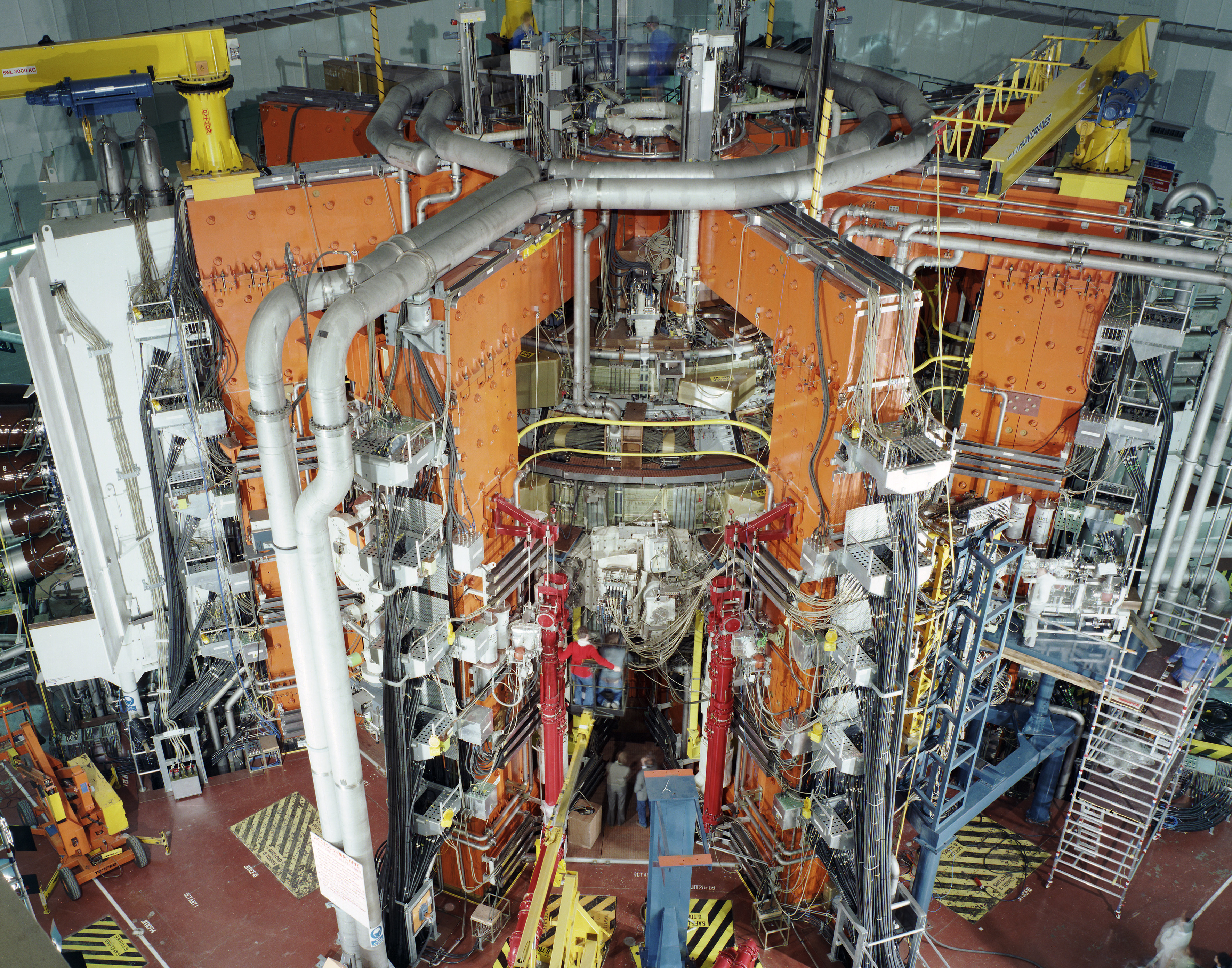|
Uragan-2M
Uragan-2M (U-2M, uk, Ураган-2М) is a stellarator (magnetic plasma confinement, controlled thermonuclear fusion experiment) installed at thInstitute of Plasma PhysicsNational Science Center, which is part of the Kharkiv Institute of Physics and Technology (IFS KIPT) in Kharkiv, Ukraine. It was the largest stellarator (torsatron) in Europe until the construction of Wendelstein 7-X. Specifications Uragan-2M is a medium-sized stellarator with reduced helical corrugations. The unit has a torus radius of , a plasma radius of up to , and a toroidal magnetic field of up to . See also * Controlled thermonuclear fusion Fusion power is a proposed form of power generation that would generate electricity by using heat from nuclear fusion reactions. In a fusion process, two lighter atomic nuclei combine to form a heavier nucleus, while releasing energy. Devices de ... References Further reading * * Stellarators Nuclear research institutes Plasma physics facilities [...More Info...] [...Related Items...] OR: [Wikipedia] [Google] [Baidu] |
Stellarator
A stellarator is a plasma device that relies primarily on external magnets to confine a plasma. Scientists researching magnetic confinement fusion aim to use stellarator devices as a vessel for nuclear fusion reactions. The name refers to the possibility of harnessing the power source of the stars, such as the Sun. It is one of the earliest fusion power devices, along with the z-pinch and magnetic mirror. The stellarator was invented by American scientist Lyman Spitzer of Princeton University in 1951, and much of its early development was carried out by his team at what became the Princeton Plasma Physics Laboratory (PPPL). Lyman's Model A began operation in 1953 and demonstrated plasma confinement. Larger models followed, but these demonstrated poor performance, losing plasma at rates far worse than theoretical predictions. By the early 1960s, any hope of quickly producing a commercial machine faded, and attention turned to studying the fundamental theory of high-energ ... [...More Info...] [...Related Items...] OR: [Wikipedia] [Google] [Baidu] |
Kharkiv
Kharkiv ( uk, wikt:Харків, Ха́рків, ), also known as Kharkov (russian: Харькoв, ), is the second-largest List of cities in Ukraine, city and List of hromadas of Ukraine, municipality in Ukraine.Kharkiv "never had eastern-western conflicts" ''Euronews'' (23 October 2014) Located in the northeast of the country, it is the largest city of the historic Sloboda Ukraine, Slobozhanshchyna region. Kharkiv is the administrative centre of Kharkiv Oblast and of the surrounding Kharkiv Raion. The latest population is Kharkiv was founded in 1654 as Kharkiv fortress, and after these humble beginnings, it grew to be a major centre of industry, trade and Ukrainian culture in the Russian Empire. At the beginning of the 20th century, ... [...More Info...] [...Related Items...] OR: [Wikipedia] [Google] [Baidu] |
Ukraine
Ukraine ( uk, Україна, Ukraïna, ) is a country in Eastern Europe. It is the second-largest European country after Russia, which it borders to the east and northeast. Ukraine covers approximately . Prior to the ongoing Russian invasion, it was the eighth-most populous country in Europe, with a population of around 41 million people. It is also bordered by Belarus to the north; by Poland, Slovakia, and Hungary to the west; and by Romania and Moldova to the southwest; with a coastline along the Black Sea and the Sea of Azov to the south and southeast. Kyiv is the nation's capital and largest city. Ukraine's state language is Ukrainian; Russian is also widely spoken, especially in the east and south. During the Middle Ages, Ukraine was the site of early Slavic expansion and the area later became a key centre of East Slavic culture under the state of Kievan Rus', which emerged in the 9th century. The state eventually disintegrated into rival regional powers and ... [...More Info...] [...Related Items...] OR: [Wikipedia] [Google] [Baidu] |
Kharkiv Institute Of Physics And Technology
The National Science Center Kharkiv Institute of Physics and Technology (KIPT) ( uk, Національний науковий центр «Харківський фізико-технічний інститут»), formerly the Ukrainian Physics and Technology Institute (UPTI) is the oldest and largest physical science research centre in Ukraine. Today it is known as a science center as it consists of several institutes that are part of the Kharkiv Institute of Physics and Technology science complex. History The institute was founded on 30 October 1928, by the Government of Soviet UkraineTaravarov, Ya. Landau in a field of negative values (Ландау в области отрицательных значений)'. Vokrug Sveta. 15 December 2008. on an initiative of Abram Ioffe on the northern outskirts of Kharkiv (in khutir Piatykhatky) as the Ukrainian Institute of Physics and Technology for the purpose of research on nuclear physics and condensed matter physics. From the ... [...More Info...] [...Related Items...] OR: [Wikipedia] [Google] [Baidu] |
Stellarator
A stellarator is a plasma device that relies primarily on external magnets to confine a plasma. Scientists researching magnetic confinement fusion aim to use stellarator devices as a vessel for nuclear fusion reactions. The name refers to the possibility of harnessing the power source of the stars, such as the Sun. It is one of the earliest fusion power devices, along with the z-pinch and magnetic mirror. The stellarator was invented by American scientist Lyman Spitzer of Princeton University in 1951, and much of its early development was carried out by his team at what became the Princeton Plasma Physics Laboratory (PPPL). Lyman's Model A began operation in 1953 and demonstrated plasma confinement. Larger models followed, but these demonstrated poor performance, losing plasma at rates far worse than theoretical predictions. By the early 1960s, any hope of quickly producing a commercial machine faded, and attention turned to studying the fundamental theory of high-energ ... [...More Info...] [...Related Items...] OR: [Wikipedia] [Google] [Baidu] |
Plasma (physics)
Plasma ()πλάσμα , Henry George Liddell, Robert Scott, ''A Greek English Lexicon'', on Perseus is one of the four fundamental states of matter. It contains a significant portion of charged particles – ions and/or s. The presence of these charged particles is what primarily sets plasma apart from the other fundamental states of matter. It is the most abundant form of [...More Info...] [...Related Items...] OR: [Wikipedia] [Google] [Baidu] |
Controlled Thermonuclear Fusion
Fusion power is a proposed form of power generation that would generate electricity by using heat from nuclear fusion reactions. In a fusion process, two lighter atomic nuclei combine to form a heavier nucleus, while releasing energy. Devices designed to harness this energy are known as fusion reactors. Research into fusion reactors began in the 1940s, but as of 2022, only one design, an inertial confinement laser-driven fusion machine at the US National Ignition Facility, has conclusively produced a positive fusion energy gain factor, i.e. more power output than input. Fusion processes require fuel and a confined environment with sufficient temperature, pressure, and confinement time to create a plasma in which fusion can occur. The combination of these figures that results in a power-producing system is known as the Lawson criterion. In stars, the most common fuel is hydrogen, and gravity provides extremely long confinement times that reach the conditions needed for fus ... [...More Info...] [...Related Items...] OR: [Wikipedia] [Google] [Baidu] |
Wendelstein 7-X
The Wendelstein 7-X (abbreviated W7-X) reactor is an experimental stellarator built in Greifswald, Germany, by the Max Planck Institute for Plasma Physics (IPP), and completed in October 2015.Introduction – the Wendelstein 7-X stellarator Retrieved 5 November 2014. Its purpose is to advance stellarator technology: though this experimental reactor will not produce electricity, it is used to evaluate the main components of a future plant; it was developed based on the predecessor experimental reactor. ... [...More Info...] [...Related Items...] OR: [Wikipedia] [Google] [Baidu] |
Magnetic Field
A magnetic field is a vector field that describes the magnetic influence on moving electric charges, electric currents, and magnetic materials. A moving charge in a magnetic field experiences a force perpendicular to its own velocity and to the magnetic field. A permanent magnet's magnetic field pulls on ferromagnetic materials such as iron, and attracts or repels other magnets. In addition, a nonuniform magnetic field exerts minuscule forces on "nonmagnetic" materials by three other magnetic effects: paramagnetism, diamagnetism, and antiferromagnetism, although these forces are usually so small they can only be detected by laboratory equipment. Magnetic fields surround magnetized materials, and are created by electric currents such as those used in electromagnets, and by electric fields varying in time. Since both strength and direction of a magnetic field may vary with location, it is described mathematically by a function assigning a vector to each point of sp ... [...More Info...] [...Related Items...] OR: [Wikipedia] [Google] [Baidu] |
Controlled Thermonuclear Fusion
Fusion power is a proposed form of power generation that would generate electricity by using heat from nuclear fusion reactions. In a fusion process, two lighter atomic nuclei combine to form a heavier nucleus, while releasing energy. Devices designed to harness this energy are known as fusion reactors. Research into fusion reactors began in the 1940s, but as of 2022, only one design, an inertial confinement laser-driven fusion machine at the US National Ignition Facility, has conclusively produced a positive fusion energy gain factor, i.e. more power output than input. Fusion processes require fuel and a confined environment with sufficient temperature, pressure, and confinement time to create a plasma in which fusion can occur. The combination of these figures that results in a power-producing system is known as the Lawson criterion. In stars, the most common fuel is hydrogen, and gravity provides extremely long confinement times that reach the conditions needed for fus ... [...More Info...] [...Related Items...] OR: [Wikipedia] [Google] [Baidu] |
Nuclear Research Institutes
Nuclear may refer to: Physics Relating to the nucleus of the atom: *Nuclear engineering * Nuclear physics * Nuclear power *Nuclear reactor * Nuclear weapon * Nuclear medicine * Radiation therapy * Nuclear warfare Mathematics * Nuclear space * Nuclear operator * Nuclear congruence * Nuclear C*-algebra Biology Relating to the nucleus of the cell: * Nuclear DNA Society *Nuclear family, a family consisting of a pair of adults and their children Music * "Nuclear" (band), group music. * "Nuclear" (Ryan Adams song), 2002 *"Nuclear", a song by Mike Oldfield from his '' Man on the Rocks'' album * ''Nu.Clear'' (EP) by South Korean girl group CLC See also * Nucleus (other) * Nucleolus *Nucleation *Nucleic acid Nucleic acids are biopolymers, macromolecules, essential to all known forms of life. They are composed of nucleotides, which are the monomers made of three components: a 5-carbon sugar, a phosphate group and a nitrogenous base. The two main cl ... * Nucular ... [...More Info...] [...Related Items...] OR: [Wikipedia] [Google] [Baidu] |








